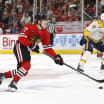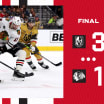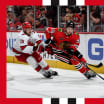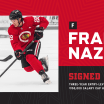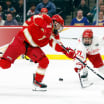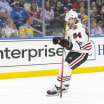This article was originally published on March 22, 2012, as Blackhawks radio voice John Wiedeman reflects on the career of one of his all-time favorite players, Al Secord, as part of the "85 Years" series.
As a longtime follower of the Chicago Blackhawks, I feel exceedingly fortunate to have indelible recollections of games played at the old Chicago Stadium. Anyone who ever witnessed a sporting event in that grand old building will probably tell you that it rivals any other as the greatest venue in professional sports history. The Stadium had a sound, a smell and, in a way, a palpable feel to it. When you were inside the Stadium and part of a Blackhawks crowd, you felt like you were among friends and family and in a sense, you were. The raucous crowds seemed to make the building come to life.
Blackhawks fans routinely flocked to the Stadium to see exhilarating, hard-hitting NHL action and many came to develop a fondness for certain players. My best memories of that incredible barn center around Blackhawks games played in the '80s and '90s. In that time, some of the greatest players the franchise has ever known -- several now in the Hockey Hall of Fame -- proudly wore the famous Indian Head logo on their chests and kept crowds entertained with world-class skill, speed, toughness, passion and intensity.
85 Years of Blood, Sweat and Cheers: Al Secord
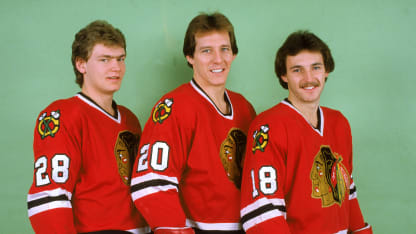
I vividly recall the nine sets of stairs one had to scale to get to the second balcony. Once up top, I took my usual position at the railing behind the last row of seats up above the Blackhawks' bench. Then I watched and waited for the boys to hit the ice. As the door swung open at ice level atop the steps from the dressing room, one by one the Blackhawks stepped onto the ice to the sounds of the Stadium's massive organ bellowing out "Here come the Hawks." This era represents one of the best times of my life; I was single, in my 20s and didn't have a lot of money, but getting to a Blackhawks game was the highlight of my week, month or even year. Some of the Blackhawks teams of the 1980s were among the best in the NHL and competed tooth and nail in the old Norris Division. These teams went to the conference finals four times in nine seasons and featured great players, some of whom we know today as icons of the organization. They were our boys and we were behind them. And though I can't say I had any one personal favorite, I did have a great deal of respect and admiration for the way one particular Blackhawk played.
When Al Secord first pulled on a Blackhawks sweater midway through the 1980-81 season, it marked the beginning of an era that few fans will ever forget. I distinctly remember the deal that brought him to Chicago, when then-GM Bob Pulford sent Mike O'Connell -- a good young defenseman -- to Boston in exchange for Secord. The rugged winger was quickly taken into the collective hearts of the Stadium faithful. In no time, Secord epitomized the popular 1980s phrase "hard Hawks hockey!" My broadcast partner Troy Murray was a teammate of Secord's for every one of his Blackhawks seasons and knew he had an ally he could count on.
"Al was a great teammate; he was always willing to stand up for you in any situation," Murray says, adding: "very few guys had the ability to score over 50 goals and have the toughness to rack up over 300 penalty minutes during a season."
A quick check of the stats reveals that in the history of the NHL, Secord is the only player ever to record at least 50 goals in one season and at least 300 penalty minutes in another.
"Big Al," or "Rocky" as many of Secord's teammates called him, brought a heavy shot, a swagger and a willingness to engage the enemy at any time and on any portion of the ice. Secord's ferocity was most often seen by his opponents, but his ability to score goals was also a tremendous asset to the teams of the 80's. His shot was strong and accurate and if he didn't score with a long-range bomb, he would go to the front of the net, trade elbows, shoves, cross-checks and punches with whomever was there. He'd often find a loose puck and either deflect it, redirect it or fire it into the opposition net. A 44-goal season in 1981-82 also featured 303 penalty minutes was followed by a 54-goal effort in 1982-83; only Bobby Hull has scored more goals (58) for the Blackhawks in a single season.
Secord's toughness and underrated level of skill would come to be appreciated by his teammates and every Blackhawks fan.
"Al was the most highly-skilled tough guy I ever played with," recalls Blackhawks Ambassador Denis Savard, the center on the famous Savard-Secord-Steve Larmer line. As that line took the ice, Secord could be seen eyeing Blackhawks opponents while he quickly took his position on the ice, then went about his physical style. Every opposing player knew when Al Secord was on the ice and most tried to avoid him. With a hard-driven shoulder he could jolt an opponent off the puck, ride him into the boards or deftly take the puck away with a skilled lifting of a stick or poke-check. With a simple cold stare, Secord could also paralyze an opponent with fear.
Secord would sometimes run an opponent with a body check and... added a terrifying alpha-dog stare. He then either got back into the play because the opponent wanted no part of him or the gauntlets came off.
When tempers flared on the ice -- as they often did in those days -- Secord could routinely be found in the middle of the fracas. On many a night at the Stadium, Secord would take the ice for a shift to cheers from the crowd. The sense of anticipation for what might happen next always kept fans on the edge of their seats and -- almost inevitably -- the payoff came. Secord would sometimes run an opponent with a body check and often added a terrifying alpha-dog stare, and then either got back into the play because the opponent wanted no part of him, or, the gauntlets came off and it was anchors aweigh!
A hockey player, especially one at the NHL level, doesn't earn the nickname "Rocky" for a Lady Byng-style of play. Just like in the Sylvester Stallone movies, Secord's fights were legendary and can still be found on various websites. The season after he recorded 44 goals and 303 penalty minutes, he recorded 54 goals while amassing 185 PIM. One could argue that had Secord cut his penalty minutes in half then he would have had more time on the ice and could have scored even more. But his teammates knew that a less-ferocious demeanor would probably have worked against Secord and the team.
I vividly recall attending a Saturday night game in St. Louis during the 1983 Stanley Cup Playoffs. The Blackhawks built a 2-0 lead on the Blues who then took umbrage with the deficit and decided to rough up a few of the Blackhawks players, namely Savard and Larmer. Secord's response was predictable and to the point: he found one of the Blues' scrappers in current Vancouver coach Alain Vigneault, a tough young player in his own right, and they had a go. Both men were extremely strong and within no time they were locked up in a bear-wrestling type of entanglement. Secord threw the first punch and eventually prevailed, landing atop Vigneault with a takedown. Blues fans detested Secord and began a derisive chant as he got up off the pile (you've heard the chant). His reaction was non-verbal: an upper-cut motion with his left fist, his right hand covering his left bicep (you know the motion). His gesture immediately drew boos, slurs and garbage from the capacity St. Louis crowd and a game misconduct from the referee. Blackhawks fans watching in the St. Louis arena, and there were several thousand, loved Secord more than ever.
The Hawks won that game and ended up sweeping the Blues in that series, then returned to Chicago to play the next round. When they next stepped onto Chicago Stadium ice for warmups for in the next game, they did so to a thunderous ovation. As Nancy Faust pounded out "Here Come the Hawks," the Blackhawks were enveloped by a roar they'd come to expect , with Secord drawing the loudest cheers of all. The Blackhawks won that playoff series as well but were eventually eliminated by the Edmonton Oilers in the conference finals. But that playoff run put the Blackhawks into the realm of beloved Chicago sports teams as Secord's popularity soared.
To every fan in the legion of Chicago Stadium diehards, Secord was a hero. Fans sang his praises in every office, factory, warehouse, ice rink and shot-n-beer tavern around Chicagoland. Blackhawks fans easily identified with a player who played hard, hit hard, fought hard, gave an honest effort every game and put the puck in the net with regularity. Secord's #20 jerseys were scattered all over the Stadium's second balcony, as well as in every other part of the building. His jersey even made it to the big screen, making a cameo appearance in the 1980's movie "About Last Night," donned by Wheaton native Jim Belushi during a table hockey scene with Rob Lowe.
Like many Hawks fans, to me, the most unforgettable portion of Al Secord's career was his time at left wing on a line with Secord and Savard. "The Party Line" combination was one of the best units in the NHL during that era and many on nights it was unquestionably the best. Future Hall of Famer Savard became best known for his speed, quickness and flair for playmaking, while Larmer was known as a pure shooter, but was also an underrated penalty-killer. Secord scored quite a few goals as well, and set up many more with muscle and quality passes. He also made sure Savard and Larmer had the necessary space on the ice.
Though he was primarily known as the left winger on that famous line, from time to time Secord was paired with other linemates and made the trio work. Though I wasn't in the Stadium on a January night in 1987 when the Hawks played Toronto, I did hear the game on the radio. Secord seemingly couldn't miss the Maple Leafs' net that night, as he struck for four goals in the second period. Current Blackhawks TV analyst Eddie Olczyk assisted on three of them.
Olczyk recalls: "It was one of those periods where Al was open every time I got the puck. Mark Lavarre and I knew to get him the puck and stay out of his way. It was surreal; the Stadium was up for grabs. It was a period of a lifetime."
As Secord rifled in no. 4, the Stadium howled and shook the way it did for playoff games.
In the summer of 1987, Secord was shipped off to Toronto, along with Olczyk in trade that brought Rick Vaive, Steve Thomas and Bob McGill back to the Hawks. On paper, the trade seemed equal but to many Hawks fans it was devastating. The Blackhawks received three players who could help their cause, and each did in his own way. But the Leafs received a talented offensive player in Olczyk and a heart-and-soul player in Secord.
After a season-and-a-half in Toronto and a stop in Philadelphia, Secord returned to the Blackhawks for his final NHL campaign in 1989 with Mike Keenan as head coach. He quickly took back the no. 20 and delivered the robust style of play that Hawks fans remembered and loved. When he scaled the stairs and stepped out onto the Chicago Stadium ice for his first game back, a sense of closure was felt by every Secord admirer. Regardless of how his season played out, the fact that Al Secord was once again a Blackhawk was enough.
Though his linemates were different many nights, on occasion he would be reunited with Savard and Larmer and the magic returned. Secord played his final NHL games with the Blackhawks in the 1990 Western Conference Finals against the Edmonton Oilers. As the teams shook hands after Game 6 at the Stadium, the Blackhawks players made their way, one by one down the Stadium steps to the dressing room. Little did anyone know that they'd seen Secord for the last time in a Blackhawks sweater.
Al Secord is now an accomplished pilot for American Airlines, but is a periodic visitor to the United Center and takes part in Blackhawk Alumni activities. He doesn't play for the team anymore, but his passion and heart will always be part of the Blackhawks' legacy.

